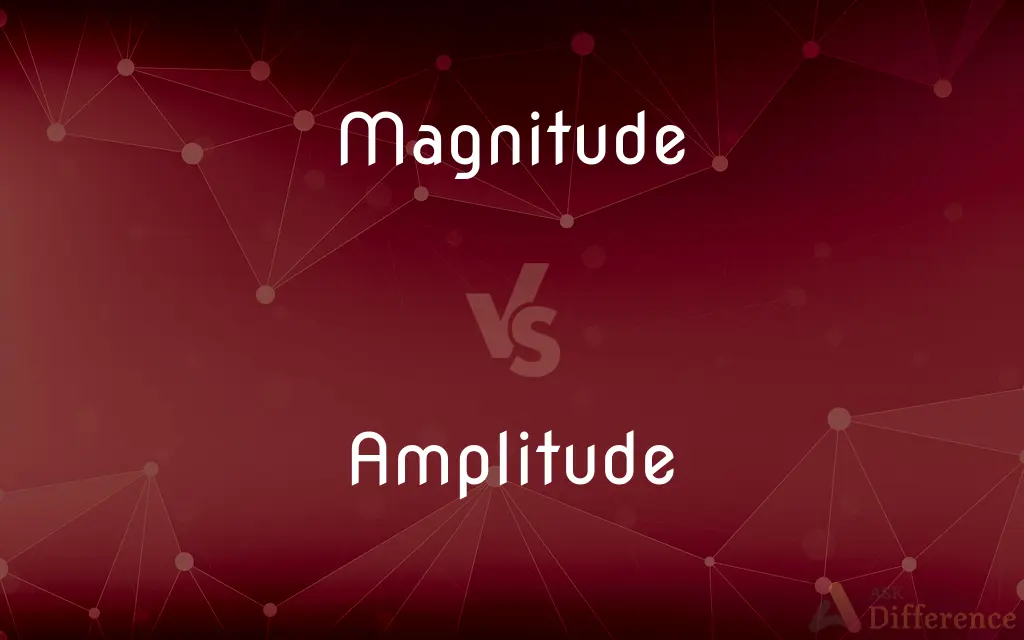Magnitude vs. Amplitude — What's the Difference?
Edited by Tayyaba Rehman — By Maham Liaqat — Updated on March 26, 2024
Magnitude measures the total energy of a phenomenon, while amplitude represents the height of a wave from its equilibrium.

Difference Between Magnitude and Amplitude
Table of Contents
ADVERTISEMENT
Key Differences
Magnitude is a term used to quantify the size, extent, or amount of a physical quantity, often used in contexts like earthquakes to describe the total energy released. It provides a scale to compare the overall power or intensity of events or phenomena, irrespective of the specifics of their manifestation. Amplitude, on the other hand, specifically refers to the maximum extent of a vibration or oscillation, measured from the position of equilibrium. It is most commonly used in the context of waves (such as sound waves, light waves, or seismic waves) to describe the height of the wave peak or the depth of the trough from the central axis.
While magnitude can apply to a wide range of phenomena and is not limited to oscillatory events, amplitude is specifically concerned with the characteristics of wave-like phenomena. For example, the magnitude of an earthquake, measured on the Richter scale, reflects the total energy released by the seismic event, whereas the amplitude of a seismic wave would describe the peak displacement of the ground during the quake.
The measurement of magnitude is often logarithmic, especially in the case of earthquakes and star brightness, meaning that a small increase in numerical value represents a significant increase in actual energy or brightness. Amplitude, however, is typically measured in linear units relevant to the type of wave, such as meters for displacement waves or decibels for sound pressure levels. This difference in measurement scales highlights the distinct ways in which magnitude and amplitude quantify aspects of physical phenomena.
Magnitude is a broader measure that can encompass the total energy output of an event or the overall intensity of a phenomenon, making it useful for categorizing and comparing events on a scale that reflects their total power or effect. Amplitude, by focusing on the specific attribute of wave height or strength, provides detailed information about the wave properties of a phenomenon, crucial for understanding and analyzing wave behaviors and impacts.
In practical applications, magnitude and amplitude serve different analytical and descriptive purposes. For instance, the magnitude of an earthquake gives scientists and engineers information about the potential for damage and energy release, while the amplitude of the seismic waves can inform more about the specific movements and forces at a particular location during the earthquake.
ADVERTISEMENT
Comparison Chart
Definition
Measures the total energy or intensity of a phenomenon.
Measures the height of a wave from its equilibrium.
Contexts
Earthquakes, star brightness, force.
Sound waves, light waves, seismic waves.
Measurement
Often logarithmic, e.g., Richter scale for earthquakes.
Linear units, e.g., meters, decibels.
Focus
Overall power or intensity.
Peak displacement or strength of oscillation.
Application
Used to compare the total energy or brightness.
Describes specific wave properties.
Compare with Definitions
Magnitude
On the overall power or effect.
The magnitude of the explosion was felt miles away.
Amplitude
On peak displacement or wave strength.
High amplitude in seismic waves can indicate strong ground movement.
Magnitude
Often logarithmic.
A one-unit increase in magnitude represents a tenfold increase in measured amplitude for earthquakes.
Amplitude
The height of a wave from its midpoint.
The amplitude of the sound wave determines its loudness.
Magnitude
A measure of the total energy or intensity.
The magnitude of the earthquake was 7.1 on the Richter scale.
Amplitude
Pertains to wave phenomena.
Light waves of higher amplitude appear brighter to the eye.
Magnitude
Helps in categorizing and comparing events.
The magnitudes of stars are compared to classify their brightness.
Amplitude
Crucial for analyzing wave behavior.
Engineers study amplitude to design better soundproofing materials.
Magnitude
Used in a broad range of phenomena.
The magnitude of her success was unparalleled.
Amplitude
Measured in linear units.
The amplitude of a water wave might be measured in centimeters.
Magnitude
Greatness of rank or position
"such duties as were expected of a landowner of his magnitude" (Anthony Powell).
Amplitude
The amplitude of a periodic variable is a measure of its change in a single period (such as time or spatial period). There are various definitions of amplitude (see below), which are all functions of the magnitude of the differences between the variable's extreme values.
Magnitude
Greatness in size or extent
The magnitude of the flood was impossible to comprehend.
Amplitude
Greatness of size; magnitude.
Magnitude
Greatness in significance or influence
Was shocked by the magnitude of the crisis.
Amplitude
Fullness; copiousness.
Magnitude
The brightness of a celestial body on a numerical scale for which brighter objects have smaller values. Differences in magnitude are based on a logarithmic scale that matches the response of the human eye to differences in brightness so that a decrease of one magnitude represents an increase in apparent brightness by a factor of 2.512. Also called apparent magnitude.
Amplitude
Breadth or range, as of intelligence.
Magnitude
A unit on such a scale of brightness.
Amplitude
(Astronomy) The angular distance along the horizon from true east or west to the intersection of the vertical circle of a celestial body with the horizon.
Magnitude
A number assigned to a quantity so that it may be compared with other quantities.
Amplitude
(Physics) The maximum absolute value of a periodically varying quantity.
Magnitude
A property that can be described by a real number, such as the volume of a sphere or the length of a vector.
Amplitude
The maximum absolute value of a periodic curve measured along its vertical axis.
Magnitude
(Geology) A measure of the amount of energy released by an earthquake, as indicated on the Richter scale.
Amplitude
The angle made with the positive horizontal axis by the vector representation of a complex number.
Magnitude
The absolute or relative size, extent or importance of something.
Amplitude
(Electronics) The maximum absolute value reached by a voltage or current waveform.
Magnitude
(countable) An order of magnitude.
Amplitude
The measure of something's size, especially in terms of width or breadth; largeness, magnitude.
Magnitude
(mathematics) A number, assigned to something, such that it may be compared to others numerically
Amplitude
(mathematics) The maximum absolute value of the vertical component of a curve or function, especially one that is periodic.
Magnitude
(mathematics) Of a vector, the norm, most commonly, the two-norm.
Amplitude
(physics) The maximum absolute value of some quantity that varies.
Magnitude
(astronomy) A logarithmic scale of brightness defined so that a difference of 5 magnitudes is a factor of 100.
Amplitude
(astronomy) The arc of the horizon between the true east or west point and the center of the sun, or a star, at its rising or setting. At the rising, the amplitude is eastern or ortive: at the setting, it is western, occiduous, or occasive. It is also northern or southern, when north or south of the equator.
Magnitude
(uncountable) The apparent brightness of a star, with lower magnitudes being brighter; apparent magnitude
Amplitude
(astronomy) The arc of the horizon between the true east or west point and the foot of the vertical circle passing through any star or object.
Magnitude
(countable) A ratio of intensity expressed as a logarithm.
Amplitude
(firearms) The horizontal line which measures the distance to which a projectile is thrown; the range.
Magnitude
(seismology) A measure of the energy released by an earthquake (e.g. on the Richter scale).
Amplitude
State of being ample; extent of surface or space; largeness of dimensions; size.
The cathedral of Lincoln . . . is a magnificent structure, proportionable to the amplitude of the diocese.
Magnitude
Extent of dimensions; size; - applied to things that have length, breadth, and thickness.
Conceive those particles of bodies to be so disposed amongst themselves, that the intervals of empty spaces between them may be equal in magnitude to them all.
Amplitude
Largeness, in a figurative sense; breadth; abundance; fullness.
Magnitude
That which has one or more of the three dimensions, length, breadth, and thickness.
Amplitude
The arc of the horizon between the true east or west point and the center of the sun, or a star, at its rising or setting. At the rising, the amplitude is eastern or ortive: at the setting, it is western, occiduous, or occasive. It is also northern or southern, when north or south of the equator.
Magnitude
Anything of which greater or less can be predicated, as time, weight, force, and the like.
Amplitude
The horizontal line which measures the distance to which a projectile is thrown; the range.
Magnitude
Greatness; grandeur.
Amplitude
The extent of a movement measured from the starting point or position of equilibrium; - applied especially to vibratory movements.
Magnitude
Greatness, in reference to influence or effect; importance; as, an affair of magnitude.
The magnitude of his designs.
Amplitude
An angle upon which the value of some function depends; - a term used more especially in connection with elliptic functions.
Magnitude
See magnitude of a star, below.
Amplitude
(physics) the maximum displacement of a periodic wave
Magnitude
The property of relative size or extent;
They tried to predict the magnitude of the explosion
Amplitude
The property of copious abundance
Magnitude
A number assigned to the ratio of two quantities; two quantities are of the same order of magnitude if one is less than 10 times as large as the other; the number of magnitudes that the quantities differ is specified to within a power of 10
Amplitude
Greatness of magnitude
Magnitude
Relative importance;
A problem of the first magnitude
Common Curiosities
Can magnitude and amplitude be used interchangeably?
No, they serve different purposes and apply to different aspects of physical phenomena.
What does the amplitude of a sound wave represent?
The amplitude of a sound wave represents its loudness, with higher amplitudes corresponding to louder sounds.
How is magnitude measured in earthquakes?
Earthquake magnitude is measured on a logarithmic scale, such as the Richter scale, indicating the total energy released.
Can the amplitude of light waves affect its brightness?
Yes, higher amplitude light waves are perceived as brighter than those with lower amplitudes.
What role does amplitude play in signal processing?
In signal processing, amplitude is crucial for determining signal strength and quality, affecting data transmission and reception.
Can we determine the damage potential of an earthquake by its amplitude alone?
While amplitude provides information about ground movement, earthquake damage potential is more accurately assessed by magnitude, which considers the total energy released.
What is the difference between magnitude and amplitude?
Magnitude quantifies the overall energy or intensity of a phenomenon, while amplitude measures the peak height of a wave from its equilibrium.
Why is magnitude often measured on a logarithmic scale?
A logarithmic scale allows for the comparison of phenomena with vastly different energy levels or intensities in a manageable way.
How does amplitude relate to wave energy?
For many types of waves, energy is proportional to the square of the amplitude, meaning higher amplitude waves carry more energy.
Is the magnitude of a star related to its brightness?
Yes, the astronomical magnitude of a star measures its brightness as seen from Earth, with lower numbers indicating brighter stars.
Share Your Discovery

Previous Comparison
Cool vs. Coolth
Next Comparison
Equity vs. AssetAuthor Spotlight
Written by
Maham LiaqatEdited by
Tayyaba RehmanTayyaba Rehman is a distinguished writer, currently serving as a primary contributor to askdifference.com. As a researcher in semantics and etymology, Tayyaba's passion for the complexity of languages and their distinctions has found a perfect home on the platform. Tayyaba delves into the intricacies of language, distinguishing between commonly confused words and phrases, thereby providing clarity for readers worldwide.














































